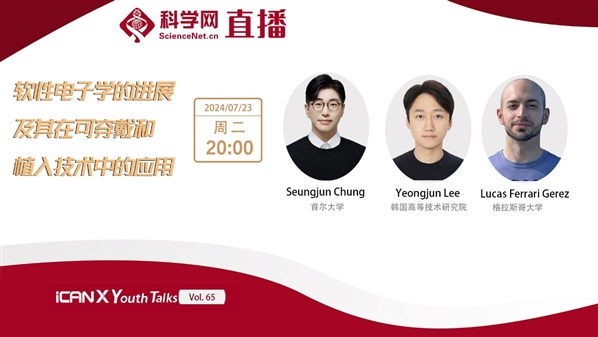|
|
|
|
|
首尔大学、格拉斯哥大学等三位专家讲述关于软性电子学的进展及其在可穿戴和植入技术中的应用 |
|
|

直播时间:2024年7月23日(星期二)20:00—22:00
直播平台:

科学网APP
(科学网微博直播间链接)
https://weibo.com/l/wblive/p/show/1022:2321325059291315830986

科学网微博

科学网视频号
【直播简介】
北京时间7月23日晚八点,iCANX Youth Talks第六十五期邀请到了首尔大学Seungjun Chung、 韩国高等技术研究院Yeongjun Lee、格拉斯哥大学Lucas Ferrari Gerez三位教授主讲,瑞士联邦材料科学实验室Sukho Song担任研讨嘉宾,格拉斯哥大学Haotian Chen教授担任主持人,期待你一起加入这场知识盛宴。
【嘉宾简介】

Seungjun Chung
首尔大学
Self-powered skin-mountable electronics
[ABSTRACT]
Printing technologies have attracted tremendous attention in the realization of customized soft electronics due to their advantages, such as non-vacuum, low-temperature, and non-contact processability. In this presentation, I would like to present our recent results of printing solid-state elastic conductors into self-supporting three-dimensional (3D) geometries that promise the design diversity of soft electronics, enabling complex, multifunctional, and tailored human-machine interfaces. Our omnidirectional printing strategies achieve superior viscoelastic properties that provide the structural integrity of printed features, and pseudoplastic and lubrication behaviors that allow great printing stability simultaneously. Freestanding, filamentary, and out-of-plane 3D geometries of intrinsically stretchable conductors are directly written, achieving a minimum feature size <80 μm and excellent stretchability >150%. To illustrate the feasibility of our approach, we demonstrate skin-mountable electronics that visualize temperature on a matrix-type stretchable display based on omnidirectionally printed elastic interconnects. In addition, I would like to introduce our recent efforts to realize high-performance soft thermoelectric generators (TEGs) which facilitate achieving high energy conversion efficiency in TEGs capable of conforming to 3D surfaces of heat sources simultaneously. Softening of TEGs allows conformal contact with arbitrary-shaped heat sources, especially in our body, which offers an opportunity to realize self-powered skin-mountable applications.
打印技术因其非真空、低温和非接触式加工能力等优势,在实现定制化软电子设备方面引起了巨大关注。在本次演讲中,我想介绍我们最近打印固态弹性导体到自支撑三维(3D)几何形状的结果,这为软电子设备的设计多样性提供了承诺,使得复杂、多功能和定制化的人机界面成为可能。我们的全方位打印策略实现了卓越的粘弹性特性,为打印特征提供了结构完整性,并且同时允许了伪塑性和润滑行为,从而实现了极高的打印稳定性。直接书写了本质上可拉伸导体的自由悬挂、丝状和离平面3D几何形状,实现了最小特征尺寸小于80微米和超过150%的卓越拉伸性。为了说明我们方法的可行性,我们展示了基于全方位打印弹性互连的皮肤可穿戴电子设备,该设备在基于矩阵型可拉伸显示屏上可视化温度。此外,我想介绍我们最近为实现高性能软热电发电机(TEGs)所做的努力,这些TEGs有助于在同时适应热源的3D表面的情况下实现高能量转换效率。TEGs的软化允许与任意形状的热源进行共形接触,特别是在我们的身体上,这为实现自供电的皮肤可穿戴应用提供了机会。
[BIOGRAPHY ]
Seungjun Chung is an Associate Professor in the School of Electrical Engineering at Korea University, Korea. He received his Ph.D. degree in Dept. of Electrical Engineering and Computer Science (EECS) from Seoul National University in 2012. Then, he joined Prof. Subramanian’s group in Dept. EECS, University of California, Berkeley as a postdoctoral researcher from 2013 to 2016. He was a Principle Research Scientist at Korea Institute of Science and Technology (KIST) from 2017 to 2023. He has published over 80 papers in numerous high-impact journals, including Nature Electronics, Nature Communications, Advanced Materials, Advanced Energy Materials, etc. Dr. Chung was a KIST Young Fellow and expert in technology level evaluation, Ministry of Science and ICT, Korea. His current research interests are in printed semiconductor devices and their physics, manufacturing of soft electronics and energy devices.
Seungjun Chung是韩国大学电气工程学院的副教授。他于2012年在韩国首尔国立大学电气工程与计算机科学系获得了博士学位。然后,他于2013年至2016年在加州大学伯克利分校的Subramanian教授组作为博士后研究员。他从2017年到2023年是韩国科学技术研究院(KIST)的首席研究科学家。他在包括Nature Electronics、Nature Communications、Advanced Materials、Advanced Energy Materials等在内的多个高影响力期刊上发表了80多篇论文。Chung博士是KIST青年研究员,也是韩国科学技术信息通信部的技术等级评估专家。他目前的研究方向是打印半导体器件及其物理、软电子和能源设备的制造。

Yeongjun Lee
韩国高等技术研究院
Soft artificial nerves for next-generation low-power neuroprosthetics
[ABSTRACT]
In modern society, the acceleration of aging and industrialization has led to a rise in brain and neural disorders, including motor neuron degeneration and spinal cord injury. These conditions significantly affect both patients lives and society. Neuroprosthetics have developed as a solution to help patients regain lost functions by replacing damaged nerves. While current neuroprosthetic devices made great advances in rehabilitation, their rigid digital components and computing systems limit their long-term usability in daily activities. Therefore, it is necessary to develop softer, biomimetic, and more power-efficient systems to create low-power, long-term wearable or implantable, and user-friendly neuroprosthetics.
In this presentation, we discuss our research on developing low-power, soft artificial nerves for next-generation neuroprosthetics. We introduce stretchable efferent nerves based on organic stretchable synaptic transistors that precisely emulate the functions of neuromuscular junctions and muscle actuation mechanisms. This enables the biomimetic actuation of artificial muscles. Furthermore, we applied these soft artificial nerves as low-power, stretchable neuromorphic implants, incorporating real-time closed-loop proprioceptive feedback to restore coordinated and smooth movements in the legs of mice with motor disorders. Our study demonstrates the potential of soft neuromorphic devices as low-power future neurorehabilitation applications.
现代社会中,老龄化和工业化的加速导致了大脑和神经疾病的增加,包括运动神经元退化和脊髓损伤。这些状况显著影响了患者的生活和社会。神经假体作为帮助患者恢复失去功能的解决方案而得到发展,通过替代受损的神经。虽然当前的神经假体设备在康复方面取得了巨大进步,但它们刚性的数字部件和计算系统限制了它们在日常生活活动中的长期可用性。因此,有必要开发更柔软、仿生、更节能的系统,以创造低功耗、长期可穿戴或可植入、用户友好的神经假体。
在本次演讲中,我们讨论了我们关于开发下一代神经假体的低功耗软人工神经的研究。我们介绍了基于有机可拉伸突触晶体管的可拉伸传出神经,这些晶体管能够精确模拟神经肌肉接头和肌肉驱动机制的功能。这使得人工肌肉的仿生驱动成为可能。此外,我们将这些软人工神经作为低功耗、可拉伸的神经形态植入物应用,整合了实时闭环本体感觉反馈,以恢复运动障碍小鼠腿部的协调和平滑运动。我们的研究展示了软神经形态设备作为低功耗未来神经康复应用的潜力。
[BIOGRAPHY]
Yeongjun Lee is an Assistant Professor in Brain and Cognitive Sciences at Korea Advanced Institute of Science and Technology (KAIST). He received his Ph.D. in Materials Science and Engineering (MSE) from Pohang University of Science and Technology (POSTECH), South Korea (2018). After that, he worked in MSE at Seoul National University as a postdoctoral researcher (2018-2019) and in Material Research Center at Samsung Advanced Institute of Technology as a staff researcher (2019–2021). From 2021 to 2024, he was a postdoctoral researcher in Chemical Engineering at Stanford University. He has published over 40 papers in various high-impact journals, including Nature Biomedical Engineering, Joule, Science Advances, Advanced Materials, Advanced Functional Materials etc. His research group currently focuses on soft polymeric materials and devices for brain-machine interfaces, stretchable/wearable electronics, and low-power neuromorphic applications to address questions in brain and cognitive sciences.
Yeongjun Lee是韩国高等科学技术院(KAIST)脑与认知科学系的助理教授。他在韩国浦项科技大学(POSTECH)获得了材料科学与工程(MSE)博士学位(2018年)。之后,他在首尔国立大学作为材料科学与工程的博士后研究员(2018-2019年),在三星先进技术研究中心作为研究员(2019-2021年)。从2021年到2024年,他在斯坦福大学化学工程系担任博士后研究员。他在包括《自然生物医学工程》、《焦耳》、《科学进展》、《先进材料》、《先进功能材料》等在内的各种高影响力期刊上发表了40多篇论文。他的研究小组目前专注于软聚合物材料和设备,用于脑机接口、可拉伸/可穿戴电子设备,以及低功耗神经形态应用,以解决脑和认知科学领域的问题。

Lucas Ferrari Gerez
格拉斯哥大学
Moving Limbs with Soft Wearable Robots
[ABSTRACT]
Soft robotics is a rapidly advancing research field that integrates robotics, design, material mechanics, chemistry, and advanced manufacturing. Unlike traditional robotics, soft robotics offers benefits such as inherent compliance, resilience, and low weight. In this talk, we will present how soft robotics technologies can be used for the development of soft exoskeletons to enhance mobility, strength, and endurance while ensuring user comfort and safety. These robots are highly adaptable, providing customizable support for a range of applications including rehabilitation, assisting the elderly and disabled, and enhancing industrial productivity. Their flexible, lightweight design made of elastomers and textile materials reduces the risk of injury and fatigue, making them ideal for prolonged use. Additionally, soft exoskeletons can improve athletic performance and aid in recovery, with their cost-effective production and maintenance further contributing to their accessibility and practicality in various fields.
软机器人学是一个快速发展的研究领域,它集成了机器人学、设计、材料力学、化学和先进制造技术。与传统机器人学不同,软机器人学提供了固有的顺应性、弹性和轻重量等优势。在本次演讲中,我们将展示软机器人技术如何用于开发软外骨骼,以增强移动性、力量和耐力,同时确保用户的舒适和安全。这些机器人高度适应性强,为一系列应用提供定制化支持,包括康复、帮助老年人和残疾人,以及提高工业生产率。它们由弹性体和纺织材料制成的灵活、轻便设计降低了受伤和疲劳的风险,使它们适合长期使用。此外,软外骨骼可以提高运动表现并帮助恢复,其成本效益的生产和维护进一步促进了它们在各个领域的可及性和实用性。
[BIOGRAPHY]
Dr Lucas Ferrari Gerez is a lecturer in Biomedical Engineering at the James Watt School of Engineering, University of Glasgow. He obtained his PhD from the University of Auckland (New Zealand), focusing on the development of wearable exoskeletons for grasping capabilities enhancement. After that, he worked as a Postdoctoral Research Fellow at the Harvard Biodesign Lab (Harvard University) on the design and development of soft, wearable robotic devices for upper-limb rehabilitation and muscle activity monitoring. Prior to joining the University of Glasgow in May 2024, Lucas was a Product Development Engineer at Fisher & Paykel Healthcare developing medical devices for acute and chronic respiratory care. Lucas won the best paper award on robot mechanisms and design at the 2021 IEEE/RSJ International Conference on Intelligent Robots and Systems (IROS). Additionally, he was awarded 1st place at the 2020 Hackaday Prize, an international open-source design competition, in the assistive devices category. He is interested in improving the quality of life of people by developing devices for rehabilitation, daily life assistance, and human performance augmentation.
Lucas Ferrari Gerez博士是格拉斯哥大学詹姆斯·瓦特工程学院生物医学工程系的讲师。他在新西兰奥克兰大学获得了博士学位,专注于开发用于增强抓握能力的可穿戴外骨骼。此后,他在哈佛大学生物设计实验室担任博士后研究员,从事上肢康复和肌肉活动监测的软性、可穿戴机器人设备的设计与开发。在2024年5月加入格拉斯哥大学之前,卢卡斯是费希尔&佩克尔医疗保健公司的产品开发工程师,负责开发急性和慢性呼吸护理的医疗设备。卢卡斯在2021年IEEE/RSJ国际智能机器人与系统会议(IROS)上获得了机器人机构和设计最佳论文奖。此外,他还在2020年Hackaday Prize国际开源设计竞赛的辅助设备类别中获得了第一名。他对通过开发康复、日常生活辅助和人类性能增强设备来提高人们的生活质量感兴趣。
【主持人】

Haotian Chen
格拉斯哥大学
【研讨嘉宾】

Sukho Song
瑞士联邦材料科学实验室
特别声明:本文转载仅仅是出于传播信息的需要,并不意味着代表本网站观点或证实其内容的真实性;如其他媒体、网站或个人从本网站转载使用,须保留本网站注明的“来源”,并自负版权等法律责任;作者如果不希望被转载或者联系转载稿费等事宜,请与我们接洽。